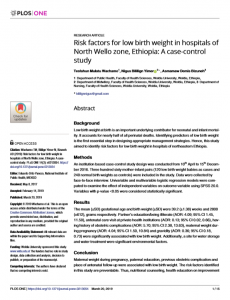
Abstract
Background
Low birth weight at birth is an important underlying contributor for neonatal and infant mortality. It accounts for nearly half of all perinatal deaths. Identifying predictors of low birth weight is the first essential step in designing appropriate management strategies. Hence, this study aimed to identify risk factors for low birth weight in hospitals of northeastern Ethiopia.
Methods
An institution based case-control study design was conducted from 10th April to 15th December 2016. Three hundred sixty mother-infant pairs (120 low birth weight babies as cases and 240 normal birth weights as controls) were included in the study. Data were collected by face-to-face interview. Univariable and multivariable logistic regression models were computed to examine the effect of independent variables on outcome variable using SPSS 20.0. Variables with p-value <0.05 were considered statistically significant.
Results
The mean (±SD) gestational age and birth weight (±SD) were 39.2 (±1.38) weeks and 2800 (±612), grams respectively. Partner’s education/being illiterate (AOR: 4.09; 95% CI 1.45, 11.50), antenatal care visit at private health institutions (AOR: 0.13; 95% CI 0.02, 0.66), having history of obstetric complications (AOR: 5.70; 95% CI 2.38, 13.63), maternal weight during pregnancy (AOR: 4.04; 95% CI 1.50, 10.84) and gravidity (AOR: 0.36; 95% CI 0.18, 0.73) were significantly associated with low birth weight. Additionally, a site for water storage and water treatment were significant environmental factors.
Conclusion
Maternal weight during pregnancy, paternal education, previous obstetric complication and place of antenatal follow-up were associated with low birth weight. The risk factors identified in this study are preventable. Thus, nutritional counseling, health education on improvement of lifestyle and early recognition and treatment of complications are the recommended interventions.
Access the original article and any supplementary material here.